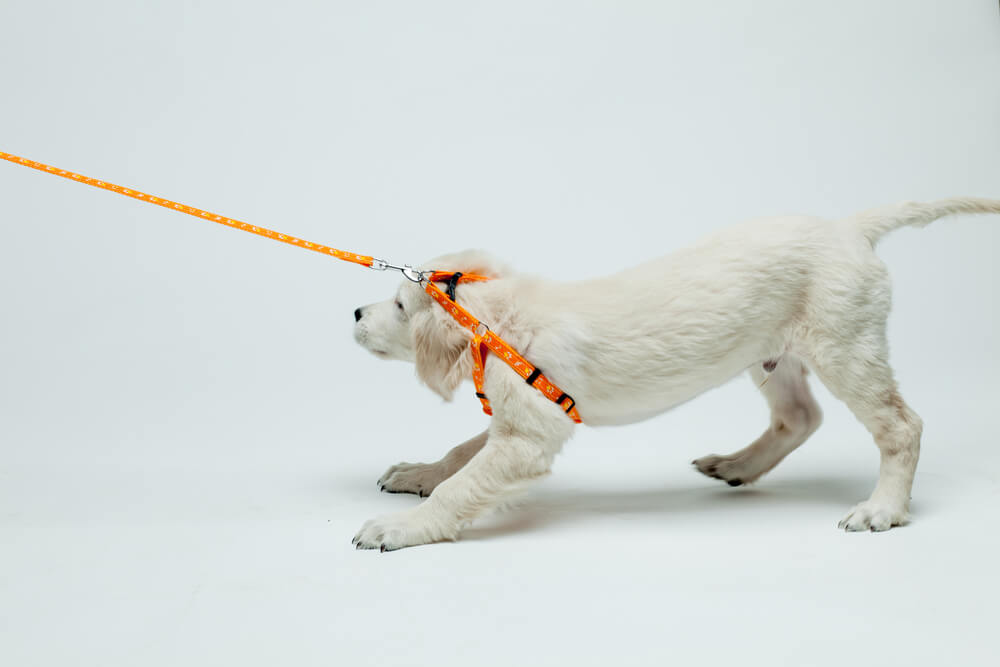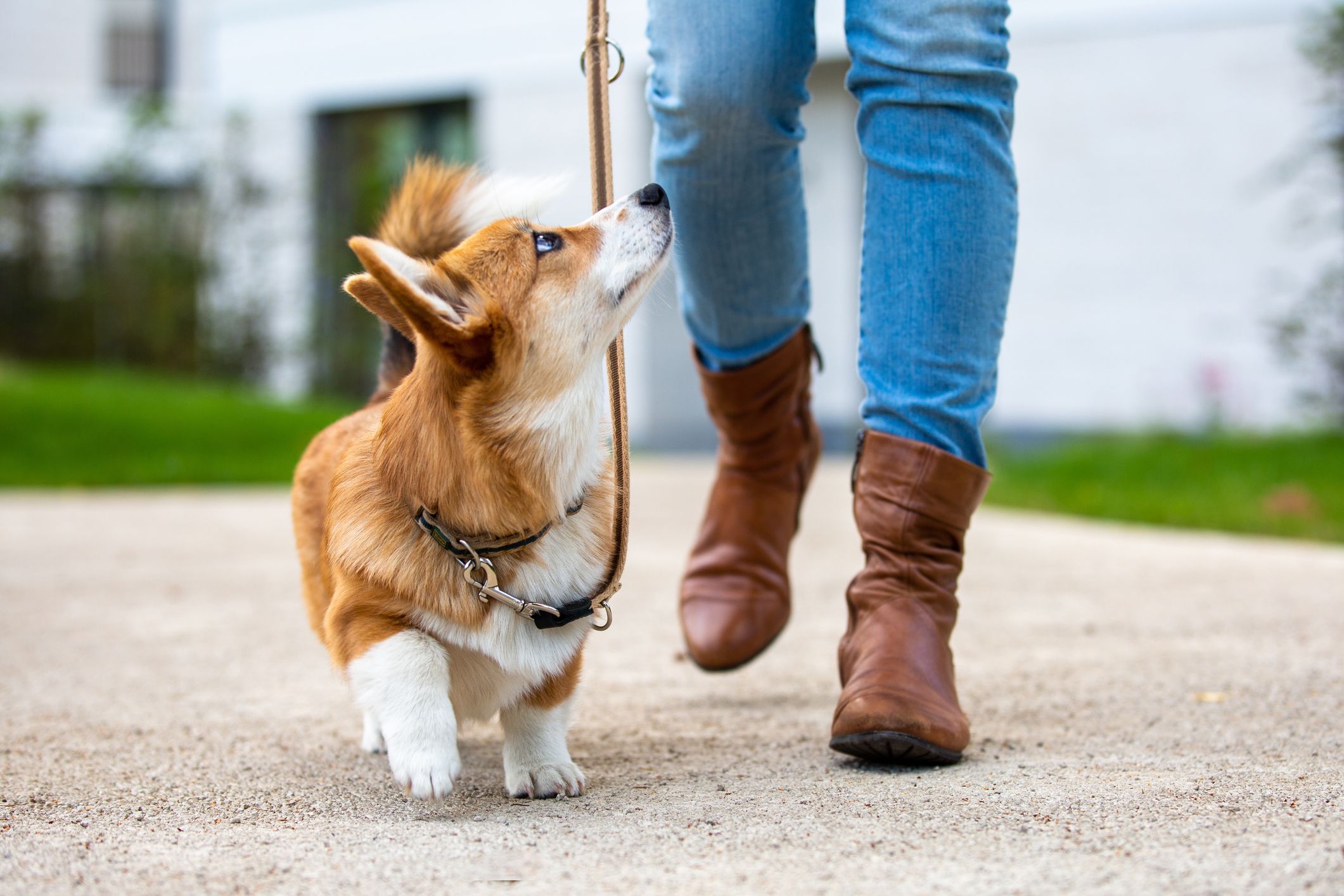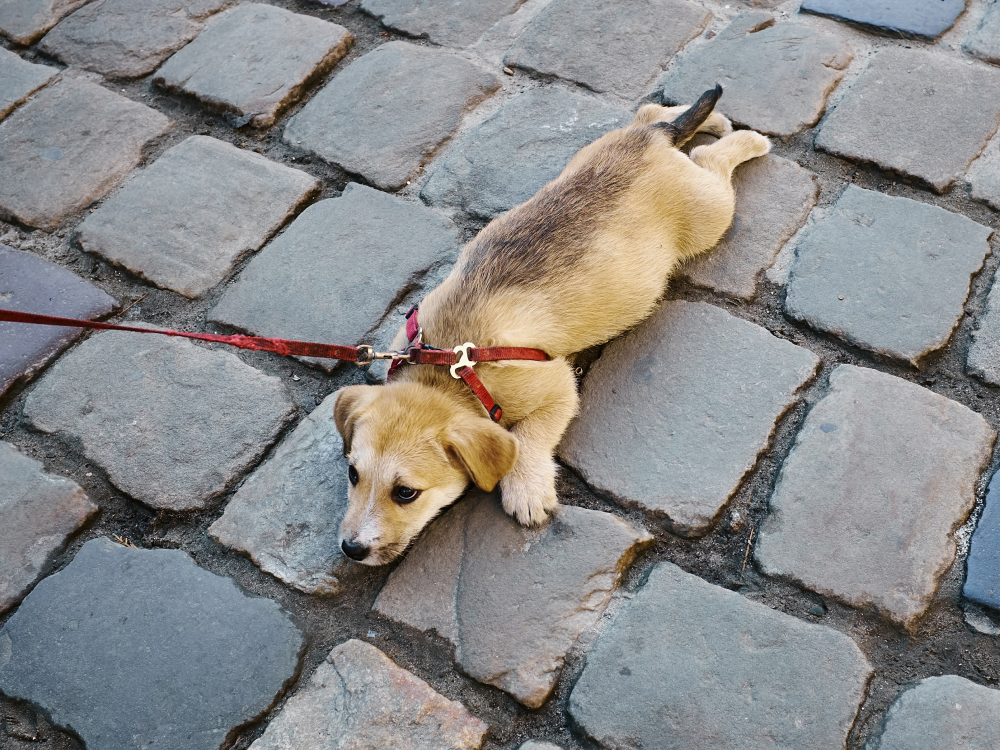If your dog doesn’t want to walk, it could be due to fear, physical pain, or anxiety. This may be caused by fear of surfaces or change, or reluctance due to physical discomfort.
Some dogs may also refuse to walk if they are anxious or have had a negative experience while on a leash. Understanding the reasons why your dog is hesitant to walk can help address the issue effectively. Seeking professional advice and a physical examination from a vet is crucial, as underlying medical conditions could also be the cause.
Recognizing and addressing your dog’s reluctance to walk will lead to a happier, healthier pet and a more enjoyable walking experience.

Credit: wagwalking.com
Common Reasons Why Dogs Refuse To Walk
Dogs may refuse to walk due to fear of surfaces, change, physical pain, or high-value treats. Get professional help if needed.
Fear Of Surfaces
Fear of surfaces can play a significant role in a dog’s reluctance to walk. Uneven or slippery surfaces, especially for smaller breeds, can be intimidating and cause anxiety, leading to refusal to walk.
Fear Of Change
Fear of change is another common reason for a dog’s aversion to walking. Dogs are creatures of habit and may exhibit reluctance when faced with new environments, schedules, or routines.
Physical Pain
Physical pain could be a factor in your dog’s refusal to walk. Joint pain, muscular discomfort, or injuries may lead to reluctance or discomfort during physical activity.
Fear Of Leaving
Fear of leaving the safety and comfort of their home can cause dogs to resist going for walks. Separation anxiety or attachment to their surroundings might make them hesitant to venture outside.
Desire For High-value Treats
Some dogs may refuse to walk due to their desire for high-value treats. If they have associated walks with treats, lack of the anticipated reward may lead to reluctance to exercise.
Seeking Professional Help
If your dog’s refusal to walk persists, seeking professional help from a veterinarian or a certified dog behavior specialist is crucial. They can identify underlying issues and provide tailored solutions to help your dog regain their enthusiasm for walks.
Understanding Sudden Changes In Dogs’ Walking Behavior
It can be concerning and confusing when your dog suddenly refuses to go for a walk. As a responsible pet owner, it is important to understand the reasons behind this behavior. Dogs are highly sensitive creatures, and there are several factors that can contribute to their sudden aversion towards walking.
Avoidance Behavior – Refusing To Continue Walking
One possible reason why your dog might not want to walk is avoidance behavior. Dogs are creatures of habit and routine. If they have had a negative experience during a previous walk, such as encountering a loud noise or feeling uncomfortable on a certain surface, they may associate those negative feelings with walking in general. As a result, they may show reluctance or outright refusal to continue walking in fear of experiencing those negative stimuli again.
Social Interaction Concerns
Social interaction is another important factor to consider when your dog doesn’t want to walk. Dogs are social animals, and they thrive on social interaction. If your dog is anxious, fearful, or has had negative interactions with other dogs or humans in the past, they may start avoiding walks as a way to avoid potential social encounters that trigger their anxiety. It is crucial to address any socialization concerns your dog may have to help them feel comfortable and confident during walks.
Summary
Understanding sudden changes in your dog’s walking behavior is essential for their overall well-being. By recognizing the possibility of avoidance behavior or social interaction concerns, you can take appropriate steps to address these issues and help your dog regain their confidence and enjoyment during walks. If your dog continues to refuse to walk despite your efforts, it is advisable to consult with your veterinarian to rule out any underlying medical conditions.
Taking Action When Your Dog Refuses To Walk
It can be concerning and frustrating when your furry friend refuses to go for a walk. There are several reasons why dogs may exhibit this behavior, such as fear, anxiety, physical discomfort, or underlying health issues. Fortunately, there are steps you can take to address this situation and ensure your dog’s well-being.
Consulting The Vet For Advice
If your dog consistently refuses to walk, it’s essential to seek professional guidance from a veterinarian. They can provide valuable insights and recommend appropriate measures to address the issue.
Book Physical Examination
Schedule a physical examination for your dog to rule out any underlying medical conditions that may be causing discomfort or reluctance to walk. A thorough assessment by a qualified vet can help identify any health issues that need to be addressed.
Identifying Underlying Medical Conditions
It’s crucial to investigate if there are any underlying medical conditions contributing to your dog’s aversion to walking. Conditions such as joint pain, arthritis, muscle injuries, or other health issues could be the underlying cause of your dog’s reluctance to walk.
Is It Normal For Dogs To Reject Walking?
If your dog is avoiding walks, it could be due to fear or anxiety in unfamiliar surroundings. Young puppies and traumatized dogs may also resist walking. Seek veterinary advice if your dog refuses to walk consistently.
Fear-related Refusals
Many dogs will experience fear-related refusals when it comes to walking. This is especially common in puppies who are going through their fear period, as well as adult dogs who find themselves in unfamiliar environments. Dogs that are anxious or fearful, or have a history of trauma, may exhibit these behaviors more frequently.
During their fear period, puppies may become scared of various elements in their environment, including new objects, people, or even different surfaces. This fear can manifest as reluctance or refusal to walk. Remember, puppies are still learning about the world around them, and it’s important to be patient and supportive during this stage of their development.
Behavioral Responses In Puppies And Adult Dogs
When a dog is fearful or anxious, they may display a range of behavioral responses during walks. Some common behavioral responses in puppies and adult dogs include:
- Plopping down or freezing: Your dog may suddenly stop moving and refuse to take another step.
- Avoiding or delaying continuing walking: Dogs may try to steer clear of certain areas or objects, or they might intentionally slow down their pace to avoid the trigger.
- Seeking social interaction: Dogs may exhibit behaviors such as seeking attention, seeking comfort from their owner, or looking for reassurance.
If your dog displays any of these behavioral responses during walks, it’s important to address the underlying cause. Identifying and understanding your dog’s specific triggers can help you develop strategies to overcome their fear and encourage them to walk again.
In some cases, fear-related refusals may also be a sign of physical pain or discomfort. If you notice any signs of pain, such as limping or avoiding putting weight on a certain leg, it’s essential to consult with your vet for a thorough examination.
Remember, every dog is unique, and their individual experiences and personalities will influence their behavior. If you have concerns about your dog’s reluctance to walk, it’s best to seek professional help to ensure the well-being and happiness of your furry friend.
Exploring Anxiety As A Cause For Refusal To Walk
Anxiety can be a significant factor contributing to your dog’s refusal to go on walks. Understanding the potential reasons behind this behavior is crucial in addressing your furry friend’s needs.
Fear Of Leash Or Outside Environment
Dogs may exhibit reluctance to walk due to fear associated with the leash or the unfamiliar outdoor surroundings. Introducing positive reinforcement techniques can help alleviate this anxiety.
Past Trauma Experiences
Previous traumatic experiences, particularly related to walking on a leash, can lead to fear and apprehension in dogs. Patience and consistent training can aid in rebuilding trust and confidence.
Avoiding Negative Reinforcement When Dealing With Dog’s Walking Refusal
Not Pushing or Dragging the Dog While Walking
Dogs can react negatively if pushed or pulled during walks, leading to further refusal.
Reasons Dog May Refuse To Walk:
- Fear of surroundings
- Anxiety or past traumas
- Physical discomfort or pain
Ensuring Positive Experience:
Provide encouragement and use positive reinforcement techniques to foster a pleasant walking experience for your dog.
| Don’t | Do |
|---|---|
| Push or drag the dog | Use treats and praise as motivation |
| Force the walk | Allow breaks and build trust |
Tips For Encouraging Walking:
- Start with short, enjoyable walks
- Bring along favorite toys or treats
- Stay calm and patient
Seek Professional Help:
If walking refusal persists, consult a veterinarian or dog behaviorist for guidance on addressing underlying issues.
Identifying Physical Issues That Hinder Dogs’ Walking
Identifying physical issues that hinder dogs’ walking is essential for understanding and addressing their reluctance to go for walks. Here are some common physical problems that can affect a dog’s ability to walk:
Joint Pain Concerns
Joint pain is a prevalent physical issue that can hinder a dog’s walking ability. Conditions such as arthritis, hip dysplasia, or ligament injuries can cause discomfort and reluctance to engage in physical activities, including walking. Dogs experiencing joint pain may exhibit signs of stiffness, limping, or difficulty getting up, all of which can contribute to their aversion to walking.
Undiagnosed Injuries
Undiagnosed injuries, such as muscle strains, sprains, or soft tissue damage, can significantly impact a dog’s willingness to walk. While these injuries may not be immediately apparent, they can cause persistent discomfort and reluctance to engage in physical activities. It’s crucial to consider the possibility of undetected injuries when a dog exhibits signs of reluctance or discomfort during walks.

Credit: blog.myollie.com
Addressing Behavioral And Environmental Factors Impacting Dog’s Walking
If your dog doesn’t want to walk, there could be various reasons behind it. It could be due to fear of surfaces, fear of change or leaving, physical pain, or the need for high-value treats. It’s important to address these behavioral and environmental factors and consider seeking professional help if necessary.
Fear, Anxiety, Or Past Trauma
One of the common reasons why dogs may not want to go for a walk is fear, anxiety, or past trauma. Many dogs experience fear or anxiety when faced with unfamiliar environments, loud noises, or encountering new people or animals. This can make them reluctant to walk and may even cause them to freeze or plop down during a walk. Additionally, dogs that have had past traumatic experiences on walks may associate walking with negative experiences, leading to their refusal to walk.
Fear
Fear can significantly impact a dog’s willingness to go for a walk. Dogs may be scared of various external factors such as new surfaces, sudden noises, or unfamiliar surroundings. For example, a dog that is afraid of walking on slippery surfaces may refuse to walk on certain pavements or floors. It is crucial to understand and identify the specific fears your dog may have and take the necessary steps to address them.
Anxiety
Anxiety is another common reason why dogs may not want to walk. Dogs with anxiety may feel overwhelmed or stressed when outside of their comfort zones. They may exhibit symptoms such as shaking, panting, or excessive drooling. It is important to create a calm and reassuring environment for your dog and gradually acclimate them to walking in new places to help reduce their anxiety.
Past Trauma
Previous traumatic experiences can have a lasting impact on a dog’s behavior, especially during walks. Dogs that have been subjected to abuse, accidents, or negative encounters while on a leash may develop a fear or aversion to walking. If your dog has a history of trauma, it is essential to be patient and provide positive reinforcement during walks, slowly building their confidence and trust.
Weather Conditions
The weather can also play a role in a dog’s reluctance to walk. Extreme heat or cold, heavy rain, or strong winds can make walking uncomfortable or even dangerous for dogs. It is important to consider the weather conditions and adjust the timing or duration of walks accordingly. Additionally, investing in appropriate protective gear such as doggy boots or raincoats can help make walks more enjoyable for your canine companion.
Lead Training
Proper lead training is crucial for successful walks. Dogs that have not been properly trained to walk on a leash may exhibit pulling, lunging, or discomfort when restrained. This can make walks unpleasant for both the dog and the owner, leading to a reluctance to go for walks. Consistent and positive reinforcement training techniques can help address leash-related issues and make walking a more enjoyable experience for your dog.

Credit: www.whole-dog-journal.com
Frequently Asked Questions
What To Do If Your Dog Refuses To Walk?
If your dog refuses to walk, seek advice from a vet to rule out any underlying medical issues. It could be fear, anxiety, or physical pain causing the reluctance. Ensure a comfortable environment and seek professional help if needed. Avoid forcing your dog to walk if they are resistant.
Is It Normal For A Dog To Not Want To Go For A Walk?
It is normal for a dog to not want to go for a walk, especially if they are afraid of their environment.
What Does It Mean When Your Dog Doesn T Want To Walk Anymore?
If your dog doesn’t want to walk, they may be scared or experiencing physical pain. Consult your vet to address any underlying issues.
Should I Carry My Dog If He Refuses To Walk?
If your dog refuses to walk, it could be due to fear, pain, or anxiety. Avoid dragging them and consult a vet for a physical examination to rule out medical issues. Encourage them with high-value treats and consider professional help if needed.
Conclusion
If your dog refuses to walk, it could be due to fear of the environment, anxiety, or physical pain. To address this, consult with a vet to rule out any underlying medical issues. Understanding your dog’s behavior and providing a safe and comfortable walking environment can help them overcome their resistance to walking.




